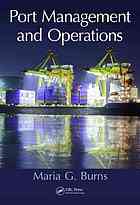Product desciption
Port Management And Operations Burns Maria G by Burns, Maria G 9781482206753, 9781482206760, 9781482206784, 9781482249224, 1482206757, 1482206765, 1482206781, 1482249227 instant download after payment.
"This book was written with the purpose of redefining the strategic role of global seaports in the present "Post-New Economy Era." Ports are these remarkable human constructions that over centuries reflect the epitome of global evolution, economic growth, and innovation. As 70.8% of the global surface is covered by water, seaports reflect all sovereign nations' political superiority and financial prosperity. Ports are the pillars of global economy, trade, and transport: 80% of global commodities are carried by water; over 4000 seaports, harbors and inland waterways, and multiple terminals per port facilitate world trade by serving over 50,000 oceangoing ships while generating over 30% of the global GDP on an annual basis. Historically, the rise and fall of empires have been associated with seaports, either through naval battles at times of war or through sea trade and transport at times of peace. In fact, superpowers and robust economies show their long-standing strength and dominance through seaports. The shipping industry has phenomenal depth, perspective, and structure, and it comprises a plethora of sciences and arts: for maritime professionals to survive in this highly competitive, rapidly changing environment, they need to possess both practical and theoretical knowledge of as many disciplines as possible, including strategic thinking; global economics; political science; laws and regulations on safety, security, the environment, and so on; trade agreements among countries; contracts; naval architecture; novel ship designs; emerging technologies; engineering; navigation; marketing; risk management; emergency response; incident investigation and root cause analysis; oceanography and weather studies; operations; bunkering; the energy markets; major global commodities, logistics, and so much more--Preface."
Abstract: "This book was written with the purpose of redefining the strategic role of global seaports in the present "Post-New Economy Era." Ports are these remarkable human constructions that over centuries reflect the epitome of global evolution, economic growth, and innovation. As 70.8% of the global surface is covered by water, seaports reflect all sovereign nations' political superiority and financial prosperity. Ports are the pillars of global economy, trade, and transport: 80% of global commodities are carried by water; over 4000 seaports, harbors and inland waterways, and multiple terminals per port facilitate world trade by serving over 50,000 oceangoing ships while generating over 30% of the global GDP on an annual basis. Historically, the rise and fall of empires have been associated with seaports, either through naval battles at times of war or through sea trade and transport at times of peace. In fact, superpowers and robust economies show their long-standing strength and dominance through seaports. The shipping industry has phenomenal depth, perspective, and structure, and it comprises a plethora of sciences and arts: for maritime professionals to survive in this highly competitive, rapidly changing environment, they need to possess both practical and theoretical knowledge of as many disciplines as possible, including strategic thinking; global economics; political science; laws and regulations on safety, security, the environment, and so on; trade agreements among countries; contracts; naval architecture; novel ship designs; emerging technologies; engineering; navigation; marketing; risk management; emergency response; incident investigation and root cause analysis; oceanography and weather studies; operations; bunkering; the energy markets; major global commodities, logistics, and so much more--Preface."


